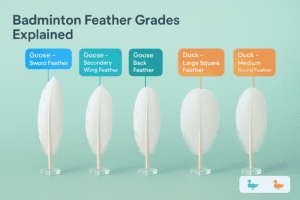Introduction
Stringing a badminton racket is an essential skill for players who want to maintain optimal performance on the court. Properly strung rackets can enhance your control, power, and overall gameplay. In this guide, we will walk you through the step-by-step process of stringing a badminton racket, from selecting the right string to finishing the job. Whether you’re a beginner or looking to refine your skills, this tutorial will help you string your racket like a pro.
Understanding the Basics
Before diving into the stringing process, it’s important to understand a few key concepts:
- String Type: Choose the right type of string based on your playing style. Common options include nylon, multifilament, and hybrid strings.
- Tension: The tension of the strings affects your racket’s performance. Higher tension offers more control but requires precise timing, while lower tension provides a larger sweet spot and more forgiving play.
Tools You Will Need
To string your badminton racket effectively, gather the following tools:
- Badminton String: Choose a suitable string based on your preference (e.g., Yonex BG66).
- Stringing Machine: A good-quality stringing machine is essential for accurate tension and consistency.
- Cutters: Use a sharp cutter to trim excess string.
- Tension Meter: Optional but useful for measuring string tension accurately.
- Awl or Stringing Tool: Helps in pulling the strings through grommets.
Step-by-Step Guide to Stringing a Badminton Racket
Step 1: Prepare Your Racket
- Remove Old Strings: If your racket has old strings, carefully cut them out using cutters.
- Inspect the Frame: Check for any damage or cracks in the frame that may affect performance.
Step 2: Measure and Cut the String
- Determine Length: For most rackets, you will need about 10 meters of string for the mains and approximately 8 meters for the crosses.
- Cut the String: Use your cutters to cut two lengths of string according to your measurements.
Step 3: Set Up Your Stringing Machine
- Mount the Racket: Securely mount your racket in the stringing machine, ensuring it is stable and properly aligned.
- Set Tension: Adjust the machine to your desired tension settings based on your playing style.
Step 4: Weave the Mains
- Start with Mains: Begin by threading one end of the first piece of string through the bottom grommet hole (usually marked).
- Weave Through Grommets: Pull it up through the corresponding hole on the opposite side. Continue weaving through each grommet hole in an alternating pattern until you reach the top.
- Tension Each String: After weaving each main string, pull it tight using the tension mechanism on your machine.
Step 5: Weave the Crosses
- Start with Crosses: Take your second piece of string and thread it through one of the top grommets.
- Weave Horizontally: Weave this string horizontally across the mains, starting from one side to another.
- Alternate Weaving Pattern: Alternate between over and under each main string as you move downwards.
- Tension Each Cross String: Pull each cross string tight using the tension mechanism after weaving.
Step 6: Finishing Touches
- Tie Off Strings: Once all mains and crosses are woven, tie off both ends securely using a double knot or a similar method to prevent them from slipping.
- Trim Excess String: Use your cutters to trim any excess string close to the knots for a clean finish.
- Final Inspection: Check that all strings are properly tensioned and that there are no loose ends.
Best Practices / Tips
- Practice Regularly: The more you practice stringing rackets, the better you’ll become at it.
- Follow Manufacturer Guidelines: Always refer to your racket’s specifications for recommended tension settings and techniques.
- Keep Tools Handy: Ensure all tools are within reach while working to streamline the process.
FAQs Section
Q1: How often should I restring my badminton racket?
A1: It depends on usage; regular players should restring every 3-4 weeks, while casual players may do so every few months.
Q2: What tension should I use for my strings?
A2: Beginners should start with lower tensions (20-24 lbs), while advanced players may opt for higher tensions (24 lbs and above) based on their skill level.
Q3: Can I use different types of strings on my racket?
A3: Yes, many players use hybrid setups with different types of strings for enhanced performance tailored to their playing style.
Conclusion
Stringing a badminton racket may seem daunting at first, but with practice and patience, you can master this essential skill. By following these steps and tips, you’ll be able to maintain your racket effectively and enhance your overall performance on the court.
If you’re looking for high-quality badminton equipment or strings, visit badmintonsupplier.com today! Elevate your game with well-maintained gear!







